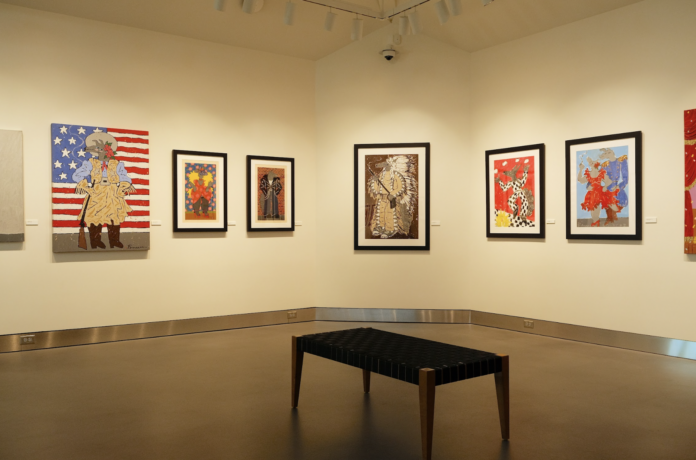The exhibition was made possible by the Shingle Springs Band of Miwok Indians, which Fonseca was an enrolled citizen of
By SAVANNAH ANNO — arts@theaggie.org
The Gorman Museum of Native American Art will be showcasing the work of Sacramento-born artist Harry Fonseca (1946-2006) from Feb. 12 to Aug. 31. Influenced by his Nisenan Maidu, Hawaiian and Portuguese heritage, Fonseca’s work — while shifting stylistically over the decades — at its core, works to challenge and expand pre-existing Western conceptions of what it means to be Indigenous.
The solo-exhibition chronicles Fonseca’s lifework, with pieces ranging from the mid-1970s to the early 2000s. The work is arranged to reflect Fonseca’s versatility and development as an artist, weaving a story between his meticulous paintings of Maidu dancers, his popular “Coyote” series, rock-art inspired “Stone Poems,” political pieces centered around the genocide of California’s native people and finally his transition to abstract art toward the end of his life.
The Gorman Museum was able to display such a wide selection of Fonseca’s work thanks to the Shingle Springs Tribe who, in 2023, brought over 1,000 of the artist’s paintings, drawings and sketches into their collection.
Fonseca was a citizen of the Shingle Springs Tribe located just east of Sacramento where he was born. Fonseca was also a student at California State University, Sacramento under Nomtipom Wintu native Frank LaPena, whose work has been shown across the country since the 1960s.
In many ways, the first exhibition of the tribe’s recent acquisition being curated at the Gorman Museum was a homecoming for Fonseca’s work back to Northern California, the largest collection previously being held at The Autry Museum of the American West in Los Angeles.
“The important thing was that we worked closely with the Shingle Springs Tribe,” Executive Director and Curator of the Gorman Museum Veronica Passalacqua said. “I’ve wanted to do a show of [Fonseca’s] work for a very long time. I was thinking I would use some from their collection and some from these other collections, but the Shingle Springs Tribe acquired so much in such a wide range, we decided to keep it within their collection and present it together.”
The Fonseca exhibit stretches across about half of the Gorman Museum’s gallery space, the rest being filled with works from their permanent collections of Native American, First Nations and Indigenous artists.
“My selection was from what I saw, knowing our space and how I could highlight each area,” Passalacqua said. “It was important to me to really emphasize the California works, even though the ‘Coyote’ series is his most popular.”
Through the strategic placement of walls and title cards in order to create physical distance between each section, visitors are able to easily grasp the various stages of artistic creation and thinking Fonseca moved through during his career.
The series Passalacqua mentions, Fonseca’s “Discovery of Gold and Souls in California,” takes up a separate wall in which visitors are able to take their time examining each small, mixed-media piece. Different from the rest of his works in which the focus is usually a detailed human or animal form, these pieces speak to the genocide of California’s indigenous communities with images of gold, crosses and handprints.
“It is a direct reference to the physical, emotional, and spiritual genocide of the native people in California. With the rise of the mission system, and much later the discovery of gold in California, the native world was fractured, and with it, a way of life and order devastated,” Fonseca said in a quote featured within the Gorman Museum’s wall text.
The exhibition includes written descriptions of each section of Fonseca’s work, with most, if not all, featuring quotes by Fonseca himself.
“We wanted those panels to be first-person quotes directly from the artist because he’s no longer with us,” Passalacqua said. “That’s part of how we operate, we’re artist-led. I’m not speaking for the artist, or asserting my education over what the artist has to say, and that’s always been important, especially when you’re talking about Native artists.
Fonseca’s words also influenced Passalacqua’s curation, paying special attention to the way he wanted pieces exhibited in the past. His “Stone Poems,” large paintings on sheets of canvas inspired by rock art and petroglyphs he studied in the West and Southwest, stand out in the exhibition’s far corner, away from the rest of the smaller works in the collection.
“Harry never wanted them on stretcher bars, he wanted them flat on the wall, so we did that per his wishes,” Passalacqua said. “But then, I also hung them a little higher than I normally would for that same idea — to emphasize that when you come up to it, you have to look up. That was how he experienced the paintings, so I thought that was important.”
With thoughtful curation, an inside look into Fonseca’s own descriptions of his artwork and the usage of a local, Native American art collection, the Gorman Museum highlights the importance of regional artists and their voice within art history.
Visitors of “Olé Ham Nees: We Call Him Coyote,” are able to experience a decades-long evolution of Fonseca’s technical skill and artistic motivations.
Centered by way of the exhibition’s name, Fonseca’s “Coyote” figure is the subject of his most-celebrated series. Beginning to draw Coyote in 1979, visitors can follow Fonseca’s sketches and watercolor prints of the dancing figure to his popular iterations of Coyote in various outfits and settings, such as the San Francisco Mission District and a performance of “Swan Lake.”
Colorful and adventurous, described by Fonseca as “a Native American folk hero,” Coyote — dressed in leather jackets, jewelry and sneakers — fights for the Native American identity to be perceived as nonstationary, as explained by the Gorman Museum’s artist biography.
Open until Aug. 31, prospective visitors have plenty of time to catch this all-encompassing exhibition of Harry Fonseca. Accessible to every kind of audience, Fonseca’s work speaks to both the playfulness and complexity of human nature.
“It’s a fabulous show and you don’t have to have Native history to appreciate it,” Passalacqua said.
Written by: Savannah Anno — arts@theaggie.org





